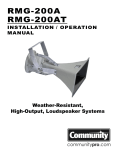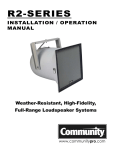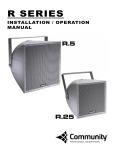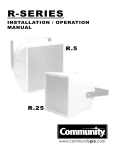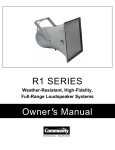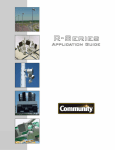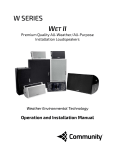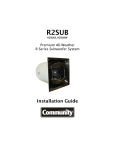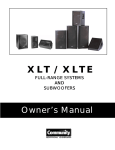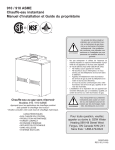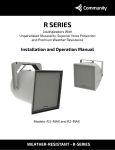Download Community R6-51 Specifications
Transcript
R6-51 R6-BASSHORN INSTALLATION / OPERATION MANUAL Weather-Resistant, High-Fidelity, High Output Loudspeaker Systems EC STATEMENT OF CONFORMITY E C S TAT E M E N T O F C O N F O R M I T Y This document confirms that the range of products of Community Professional Loudspeakers bearing the CE label meets all of the requirements in the EMC directive 89/336/EEC laid down by the Member States Council for adjustment of legal requirements. Furthermore, the products comply with the rules and regulations referring to the electromagnetic compatibility of devices from 30-August-1995. The Community Professional Loudspeaker products bearing the CE label comply with the following harmonized or national standards: DIN EN 55013:08-1991 DIN EN 55020:05-1995 DIN EN 55082-1:03-1993 The authorized declaration and compatibility certification resides with the manufacturer and can be viewed upon request. The responsible manufacturer is the company: Community Light & Sound 333 East Fifth Street Chester, PA 19013 USA TEL: 1-(610) 876-3400 FAX: 1-(610) 874-0190 Chester, PA USA February 2011 FIND THE LATEST ONLINE Every effort has been made to ensure that the information contained in this manual was complete and accurate at the time of printing. However, due to ongoing technical advances, changes or modifications may have occurred that are not covered in this publication. The latest version of this manual and the most recent product information published by Communtiy is always available at http://www.communitypro.com on the world wide web. The publication date can be found on the rear cover of this document. Community R6-51 and R6-BASSHORN Installation / Operation Manual — Page 2 WELCOME TO COMMUNITY A TRADITION OF EXCELLENCE AND I N N O VAT I O N . . . S PA N N I N G M O R E T H A N 4 0 Y E A R S ! Since the founding of our company in 1968, Community has been a constant developer and innovator of loudspeaker technology. Many of our engineering achievements were undertaken to solve problems, when no prior solutions existed, while others were the result of simply seeing a better way to do things. Over the years our technologies have been imitated, and our methods have become common practice throughout the professional sound industry. However, developments like carbon fiber diaphragm compression drivers still stand alone, and well ahead of the competition. Just a few of Community’s unique accomplishments include the following: First successful fiberglass mid-frequency, high-frequency, and large-format bass horns. First compression loaded mid-range horn for touring systems - the LMF. • First suspension-less diaphragm HF driver - the VHF100. • First mid-range, full-decade (200 Hz - 2 kHz) high-power compression driver - the M4. • First carbon fiber diaphragm compression drivers - M4, EM280, EM282. • First Ferrofluid-cooled professional woofers - the VBS Series. • First product series with all drivers Ferrofluid-cooled. • First air-cooled loudspeakers for touring systems - AirForce. • First three-way cinema loudspeaker systems - Paramount Executive Studio Theatre, Warner Bros. screening theatre and dubbing rooms. • First electro-acoustic system to equal the sound level of pneumatic warning sirens. • First to provide loudspeaker coverage over an entire country - Denmark Emergency System. • First comprehensive, calibrated data acquisition of sound reinforcement products. • First integral signal-aligned three-way sound reinforcement systems - RS Series. • First pro audio company with an Internet Web site. • First all horn-loaded, high-fidelity, weather-resistant loudspeakers - R2 Series. • • In line with our history of excellence and innovation, each Community product is manufactured in accordance with a complicated and exacting chain of procedures that ensure absolute quality and uniformity. With our unique designs, our sophisticated techniques, and our proprietary materials and transducers, we are committed to bringing only the finest audio products to the many thousands of professional sound engineers, performers, and end users who rely on them daily. Community Professional Loudspeakers 333 East Fifth Street Chester, PA 19013-4511 USA TEL: 1-(610) 876-3400 FAX: 1-(610) 874-0190 www.communitypro.com © 2011 All Rights Reserved Community R6-51 & R6-BASSHORN Installation / Operation Manual — Page 3 TABLE OF CONTENTS TOPICS EC Statement of Conformity ...................................................................................................... Page 2 Welcome to Community ............................................................................................................ Page 3 Important Safety Information ..................................................................................................... Page 5 Unpacking, Inspection, and Damage Claims ............................................................................. Page 6 Introduction / Features ............................................................................................................... Page 7 Product Descriptions ................................................................................................................ Page 8 Quick Start-up Guide / Basic Features ...................................................................................... Page 9 Signal Processing .................................................................................................................... Page 10 Power Amplification ........................................................................................................ Pages 10 - 11 Use of Protective Limiting ........................................................................................................ Page 11 Electrical Installation / Connecting to the Loudspeaker .................................................. Pages 11 - 12 Mounting Point Dimensions ..................................................................................................... Page 13 Mechanical Installation ................................................................................................... Pages 14 - 15 Rigging Considerations ........................................................................................................... Page 16 Dimensioned Drawings ............................................................................................................ Page 17 Technical Specifications ................................................................................................. Pages 18 - 19 System Optimization ................................................................................................................ Page 20 Internal Wiring Guide ............................................................................................................... Page 21 In Case of Difficulty .................................................................................................................. Page 22 Warranty / Service Information ....................................................................................... Pages 23 - 24 Installation Notes ..................................................................................................................... Page 25 The Complete R-Series Family ............................................................................................... Page 26 R-Series Operating Distances ................................................................................................. Page 27 Contact Information ................................................................................................................. Page 28 Community R6-51 and R6-BASSHORN Installation / Operation Manual — Page 4 IMPORTANT SAFETY INFORMATION I M P O R TA N T S A F E T Y I N F O R M AT I O N Always follow these basic safety precautions when using or installing R-Series loudspeakers and accessories: Read these instructions. Keep these instructions. Heed all warnings. Follow all instructions, particularly those pertaining to rigging, mounting, suspension of the product, and electrical connections. The terms IMPORTANT, CAUTION, and DANGER are used throughout this manual to alert the reader to important safety considerations. If you have any questions or do not understand the meaning of these terms, do not proceed with installation. Contact your local dealer, distributor, or call Community directly for assistance. These terms are defined below: IMPORTANT: describes an operating condition or user action that may expose the equipment or user to potential damage or danger. CAUTION: describes an operating condition or user action that will likely cause damage to the equipment or injury to the user or to others in the vicinity. DANGER: describes an operating condition or user action that will immediately damage the equipment and/or be extremely dangerous or life threatening to the user or to others in the vicinity. RIGGING AND ELECTRICAL SAFETY DANGER: The loudspeakers described in this manual are designed and intended to be ‘flown,’ mounted, or suspended for maximum acoustical performance using a variety of rigging hardware, means, and methods. Installation of the loudspeakers should only be performed by trained and qualified personnel. It is strongly recommended that a licensed and certified professional structural engineer approve the mounting design. Severe injury and/or loss of life may occur if these products are improperly installed. DANGER: R-Series rigging fittings are rated at a Working Load Limit (WLL) of 100 lbs (45.4kg) with a 10:1 safety margin. No single rigging fitting should ever be subjected to a load that is greater than this stated limit. Failure to heed this warning could result in severe injury and/or loss of life. IMPORTANT: Refer to the sections on installation and connections later in this manual for additional information on rigging and electrical safety. IMPORTANT: The stainless steel mounting bolts that come installed in each enclosure must either be used to mount the Accessory Mounting Yoke or they must be kept in place to seal the enclosure from air leaks. If the rigging fittings do not remain sealed, air leaks will occur in the enclosure that will compromise the loudspeaker’s weather-resistance and its low frequency performance. Community R6-51 & R6-BASSHORN Installation / Operation Manual — Page 5 UNPACKING U N PA C K I N G A N D I N S P E C T I O N R-Series loudspeakers are inherently rugged and are carefully packed in sturdy cartons. However, it’s wise to thoroughly inspect each unit after it has been removed from the packaging, as damage may have occurred during shipping. SHIPPING CLAIMS Please note that once the shipment has left your dealer or the Community factory, the responsibility for damage is always borne by the freight company. If damage has occurred during shipping, you must file a claim directly with the freight company. It’s very important to contact the freight company as soon as possible after receiving your shipment, as most freight companies have a short time limit within which they will investigate claims. Make sure to save the carton and the packing materials, as damage claims can be denied if these materials are not retained. If there is evidence of physical damage to the carton upon arrival, be very careful before signing a delivery receipt. Often, the fine print in a delivery receipt will waive your right to file a claim for damage, or loss, after you sign it. Your Community dealer and the factory will try to help in any way they can, but it is the responsibility of the party receiving the shipment to file the damage claim. This is a provision of law in the USA and in most countries. It’s always a good idea to retain the carton and packing materials indefinitely, if possible, in the event that the product may need to be returned to your dealer or distributor for repair in the future. W H AT ’ S I N T H E B O X Each shipping carton contains the following items: • (1) R6-BASSHORN • (1) R6-51 full-Range Loudspeaker • (1) Installation/Operation Manual • (1) Warranty Card or PURPOSE OF THIS MANUAL This manual is intended to help you install and use the R6-BASSHORN and the R6-51 loudspeakers safely and effectively. It provides useful information to help you obtain the best performance, sound quality, and reliability from these systems. We’ve provided a Quick-Start diagram to enable you to install and operate the products immediately, but we recommend that you read this manual in its entirety to ensure that your installation meets the highest possible standards. While every attempt has been made to ensure this information is correct and up-to-date, Community continuously incorporates worthwhile improvements to each product which may include changes and/or modifications not contained in this manual. Please visit us on the web at http://www.communitypro.com to verify that you have the most up-to-date information. Community R6-51 and R6-BASSHORN Installation / Operation Manual — Page 6 INTRODUCTION / FEATURES INTRODUCTION TO THE R6-BASSHORN AND THE R6-51BIAMP LOUDSPEAKERS All-Weather, All-Purpose The R6-BASSHORN and R6-51 are large-format, very high-power loudspeakers intended for use in demanding applications that require extreme output levels. They are designed to handle the harshest outdoor environmental conditions, but it should be kept in mind that they are often the ideal choice for indoor environments as well. Both models are fully horn-loaded, manufactured from hand-laid fiberglass, and powered by industry-leading electro-mechanical drivers. Horn-loading provides the highest possible efficiency, excellent transient response, and predictable pattern control - all of which equate to superior sound quality. Fiberglass construction ensures that these loudspeakers can withstand continual exposure to the elements and are free from the decomposition that can occur over time with wood-based products. Community’s proprietary drivers provide superb sonic quality and are engineered for durability and longevity. They exhibit exceptional resistance to potentially damaging environmental conditions, as do the enclosures themselves. Both models meet the needs of numerous applications, some of which are listed below: TYPICAL APPLICATIONS • • • • • • • • • • • • • • • • • • Stadiums Athletic Fields (football, soccer, baseball, tennis) Sports Arenas Music Pavilions Racetracks & Motor Speedways Gymnasiums & Field Houses Theme Parks and Amusement Parks Swimming Pools and Water Parks Ski Slopes Cruise Ships Carillons Fairgrounds Rodeos Air Shows Skating Rinks Convention Centers Factories & Warehouses Portable Sound for Live Outdoor & Indoor Events Please see our comprehensive 60 page R-Series Application Guide for advice and information on how to best utilize the R6-51 and R6-BASSHORN, as well as how to utilize other R-Series loudspeakers. The Guide contains a wealth of knowledge, along with numerous examples of successful installations. Community R6-51 & R6-BASSHORN Installation / Operation Manual — Page 7 PRODUCT DESCRIPTIONS R6-BASSHORN PRODUCT DESCRIPTION The R6-BASSHORN is a high-output low frequency system designed for long throw applications in sports arenas, stadiums, and other large facilities that require high power levels coupled with superb clarity. The R6-BASSHORN has been designed to work in an array with like units. As more units are employed, the control of acoustic dispersion becomes increasingly more directional and more effective at focusing the sonic energy. Additionally, mutual coupling of adjacent enclosures will result in higher efficiency at lower frequencies. The R6-BASSHORN employs six high-sensitivity 12-inch drivers designed with powerful, heavy-duty motor structures. These drivers are mounted to a one-piece fiberglass 42 Hz flare rate horn (this equates to the lowest note on a bass guitar), and are surrounded by a rigid fiberglass weatherproof cap. The R6-BASSHORN is designed as the ultimate low frequency complement to Community’s horn loaded full-range systems (such as the R2 and other R-Series products). Please note that proper implementation with an associated full-range system will require an electronic crossover, signal alignment delay, and appropriate equalization in order to optimize the potential of this product. R6-51 PRODUCT DESCRIPTION The R6-51 is essentially the same as the R-6 BASSHORN, but with the addition of high-power mid-frequency and high-frequency sections. Internally, the driver components are arranged in three distinct line-array formations. This gives the R6-51 the same long-throw capabilities as that of separate, discreet line array enclosures but contained in a single, easy to install package that is capable of sustaining long-term outdoor use. The R6-51 is Community’s largest ‘one-piece’ solution for the most demanding of applications. It features a high -fidelity, wide-range response that’s capable of accurately reproducing any musical genre, while simultaneously providing superb projection of clear and intelligible speech with very low distortion. The R6-51 BIAMP is the ideal primary system for applications requiring high-impact, long throw full-range performance. For applications that require a combination of both long-throw and short-throw loudspeaker systems, the R6-51 can readily be augmented with other R-Series loudspeakers, as well as any of the models in the WET Series II product family, CROSSOVER The mid-frequency and high-frequency drivers are acoustically mated through the use of a high quality two-way passive crossover using 250V Mylar capacitors and precision wound inductors. No crossover is provided between the low-frequency and mid-frequency section because this product is designed to use an outboard electronic crossover to divide the frequency bands prior to amplification; hence the name “R6-51 BIAMP.” CAUTION: The R6-51BIAMP loudspeaker MUST be used with an external electronic crossover to provide separate low-frequency and mid/high frequency outputs. Any attempt to operate this system without the required crossover will result in rapid failure of the mid and high frequency drivers. WEATHER-STOPTM GRILLE Both the R6 BASSHORN and the R6-51 loudspeakers are fitted with Community’s proprietary Weather-Stop™ protective grille. These grilles consists of a corrosion-resistant outer layer of perforated steel with a proprietary zinc-rich epoxy dual-layer powder coat finished in light grey. A center layer of UV-resistant reticulated foam and an inner layer of fine-mesh screen made from a UV-resistant synthetic material blocks rain and fights rusting. This grille assembly resists water intrusion, while providing the proper degree of acoustical transparency. Community R6-51 and R6-BASSHORN Installation / Operation Manual — Page 8 QUICK START-UP GUIDE P H Y S I C A L F E AT U R E S O F T H E R 6 & R 6 - 5 1 NOTE: The numerical callouts show the typical location of the primary physical features of the R6 and R6-51 loudspeaker enclosures. Not all mounting points, grille fasteners, or supplementary mounting holes are shown in order to make the illustration as clear as possible. 1 2 3 FEATURE DESCRIPTION Mounting/Rigging Points Four total; two on the rear and one each on the top and bottom. Rigging points are 1/2"13 captive stainless steel bolts fitted with lock, flat and rubber washers. Used for attaching to customer-supplied mounting system. Supplemental Mounting Points Ten 5/16” holes on front mounting flange intended to provide additional support. CAUTION: NOT FOR USE AS PRIMARY SUPPORT OR FOR SAFETY CABLES. Weather– Stop Grille Perforated steel with a two layer powder-coated finish. Backed by a layer of UV-resistant reticulated foam and a fine mesh screen. Avoids damage to drivers by resisting inclement weather. The grille assembly is retained by 28 #6 stainless steel SMS screws. 4 Mid-High Frequency Horn Mounts Three 3/8”-16 stainless steel hex head bolts each on the top and bottom. Used to retain the mid-high frequency horn assembly to the horn enclosure. CAUTION: NOT FOR ENCLOSURE SUSPENSION/MOUNTING Connects the amplifier to the loudspeaker. The R6-BASSHORN uses a single cable consisting of 12 feet of 16-2 SJOW retained by a factory-sealed gland-nut. 5 Input Cable The R6-Biamp uses two cables, one for low frequencies and one for mid/high frequencies. The R6-Triamp uses three cables, one for low frequencies, one for mid frequencies, and one for high frequencies. 6 Structural Support Four 1/4”-20 stainless steel bolts on each side used as structural support between shell and flare. CAUTION: NOT FOR USE AS PRIMARY SUPPORT OR FOR SAFETY CABLES. Community R6-51 & R6-BASSHORN Installation / Operation Manual — Page 9 SIGNAL PROCESSING H I G H - PA S S F I LT E R The R6-51 and the R-6 BASSHORN use fully horn-loaded low frequency drivers. The specified low frequency response is 45 Hz. Any attempt to reproduce significant levels below this frequency can result in over-excursion of the low frequency drivers. For this reason a 45 Hz electronic high-pass filter with a minimum slope of 12 dB per octave must be employed. Its usage will protect the drivers from much of the extreme low frequency content found on certain CDs and other program sources. The high-pass filter will also protect against unwanted low frequency energy that can originate from microphone wind noise - an important consideration for outdoor applications. Many power amplifier manufacturers offer plug-in input modules that include high-pass filters. This is an excellent way to provide the necessary high-pass filter and to make the system relatively tamperproof. Alternately, an outboard loudspeaker controller will provide the necessary crossover functions while also (typically) offering an adjustable high-pass filter that will fulfill this requirement. IMPORTANT: Operating the R6-51 or the R-6 BASSHORN loudspeakers without the recommended high-pass filter will reduce its low frequency power handling, and may result in physical damage to the low-frequency drivers. E Q U A L I Z AT I O N Small amounts of frequency boost can brighten-up the higher frequencies and round out the lower frequencies, but they should be restricted to no more than approximately +3 dB in order to avoid damage to the drivers. Equalization cuts can be very effective for removing the effects of room resonance and other unwanted acoustical artifacts, but here again should be kept to a minimum. Extreme EQ cuts (or attenuation) will not cause driver damage, but should be used with discretion to avoid acoustic ‘holes’ in the audible spectrum. External equalization can be used to "voice" the loudspeaker for particular applications and is especially effective in attenuating feedback-prone frequencies. CAUTION: Do not attempt to boost frequencies at, or below 40 Hz with an equalizer (either graphic or parametric). This will counteract the effect of the high-pass filter discussed above, potentially causing damage to the drivers. P O W E R A M P L I F I C AT I O N Power amplifiers for the R6-51 and the R-6 BASSHORN should be capable of providing enough power to properly drive the loudspeaker without the amplifiers entering into a state of clipping. Clipping occurs when an amplifier runs out of power. The peaks of the reproduced waveform begin to ‘clip’ and resemble a square wave instead of the typical sine waves and saw-tooth waves that form the basis of most speech and music. Clipping leads to rapid driver failure because the driver is no longer moving as it’s designed to. When power is flowing into a driver, but movement is limited because of amplifier clipping, much of the energy is converted to heat which will soon cause the driver’s voice coil to burn out. Community R6-51 and R6-BASSHORN Installation / Operation Manual — Page 10 POWER AMPLIFICATION POWER RATING Power handling of the Low Frequency section of the R6-51BIAMP and the R-6 BASSHORN is rated at 1200 Watts continuous and 3000 Watts program. An amplifier that is capable of providing a continuous output of 2500 Watts to 3000 Watts into a 4 ohm load is recommended. It is better to oversize the amplifier than to undersize it. The Mid/High Frequency section of the R6-51BIAMP is rated at 450 Watts continuous and 1100 Watts program. An amplifier that is capable of providing a continuous output of 900 Watts to 1400 Watts into an 8 ohm load is recommended. Here again, it is better to oversize the amplifier than to undersize it. PROTECTIVE LIMITING We recommend the use of a high quality signal limiter to help prevent loudspeaker damage due to sudden transients (dropped microphones, etc.) and/or damage from amplifier clipping. The limiter should be connected as the last device in the signal chain before the power amplifier. Alternately, most modern DSP based loudspeaker processors (also called loudspeaker controllers or loudspeaker management systems) have built-in dynamic capabilities that can provide the recommended limiting functionality. The limiter should be set to a limiting ratio of 20:1 (or greater), thereby providing near ‘brick-wall’ protection against amplifier clipping. The limiter should also restrict output voltages to a maximum of 69VRMS for the R6-BASSHORN and the low frequency section of the R6-51BIAMP full-range. The Mid/High section of the R6-51BIAMP should be restricted to a maximum of 60VRMS. AMPLIFIERS WITH BUILT-IN LIMITING Power amplifier manufacturers have introduced amplifiers with built-in limiting. These limiters are usually designed to prevent the amplifier from clipping. This type of limiting is acceptable to use in lieu of a stand-alone limiter because it is easy to set-up, is specifically designed for the amplifier, and in most cases is tamper-proof. This assumes that the amplifier output is sized as recommended in “Power Amplification” that begins on page 10. CONNECTING THE LOUDSPEAKER The R-6 BASSHORN has a 12 ft (3.6m) 16-2 SJOW-type neoprene jacketed cable attached to its enclosure with a weather-tight gland-nut. R6-51BIAMP has two of these same cables, one for its low frequency section and one for its mid/high-frequency section. In both products these ‘pigtails’ (as they’re sometimes called), are for connection to the amplifier(s). This cable may be connected to the amplifier’s speaker cabling using solder, a terminal block, crimped connections, or wire-nuts. Make sure to provide the connections with a weather-resistant treatment if used outdoors. This can take the form of a weatherproof junction box (recommended) or a coating of a dielectric compound such as “CRC Dielectric Grease” or a similar product. In all cases, do not remove the gland nut that attaches the cable to the lower rear of the loudspeaker, as this will compromise the weather integrity of the enclosure. Community R6-51 & R6-BASSHORN Installation / Operation Manual — Page 11 ELECTRICAL INSTALLATION block, crimped connections, or wire-nuts. Make sure to provide all connections with a weather-resistant treatment if used outdoors or in potentially harsh indoor environments. This can take the form of a weatherproof junction box (recommended), do not remove the gland nut that attaches the cable to the lower rear of the loudspeaker, as this will compromise the weather integrity of the enclosure. All terminations should conform to local electrical codes and industry best practices. Connector Cable Polarity: The white jacketed conductor is the positive or + signal wire and the black is the negative or – signal wire. Positive voltage applied to the + wire produces positive acoustic pressure at the mouth of the loudspeaker. LOUDSPEAKER CABLE The resistance of the cable that connects the loudspeaker to the amplifier will affect the performance of the loudspeaker. Cable with too high of a resistance will cause power losses and impair the frequency performance of the system by reducing the electrical damping factor. To minimize these issues it is desirable to keep the total cable resistance under 0.2 ohm. However, for lengths over 100 feet, the wire gauges needed to meet this requirement are usually not a practical choice for both physical and cost reasons. Therefore #10 AWG (American Wire Gauge) is recommended as the most practical gauge for installations that require 100’ (or greater) distances. Both stranded and solid conductors are acceptable, although cable with stranded conductors is often easier to work with. The length of both conductors has been calculated into the total resistance in the table shown below. Note that the lower the gauge number, the larger the wire size. It is always desirable to locate amplifiers as close to the loudspeakers as possible, thereby minimizing the cost of the loudspeaker cable, as well as reducing the inherent electrical losses that result from long cable runs. When installed outdoors, cable insulation should be resistant to water, temperature, and ultraviolet exposure. Recommended cable compositions include polyethylene, neoprene, Teflon™, Silicon™, and Hypalon™. Cable compositions that are NOT recommended are Rubber, PVC, polypropylene, polyurethane, and nylon. Run Length Minimum Wire Gauge (American Wire Gauge) Total Resistance 10 ft. (3m) 16 AWG 0.08 ohm 25 ft. (8m) 14 AWG 0.13 ohm 50 ft. (15m) 12 AWG 0.16 ohm 75 ft. (25m) 10 AWG 0.15 ohm 100 ft. (30m) Contact Technical Application Team (TAG) Team for recommended wire gauge. Recommended Wire Gauge vs. Distance Community R6-51 and R6-BASSHORN Installation / Operation Manual — Page 12 MOUNTING POINT DIMENSIONS Community R6-51 & R6-BASSHORN Installation / Operation Manual — Page 13 MECHANICAL INSTALLATION GENERAL MOUNTING INSTRUCTIONS The R6-51 and the R-6 BASSHORN are each equipped with four primary mounting points. Each point consists of a 1/2”-13 threaded inset. In all cases, a minimum of two points - on opposite sides of the enclosure - (total of four points) should be used to mount R6-51 or R-6 BASSHORN loudspeaker. ACCEPTABLE MOUNTING POINT LOADING The mounting points should always be used so that either (1) shear force is applied perpendicular to the direction of the mounting hole or (2) tension force is applied perpendicular to the enclosure surface. They should be tightened to a setting of 35 foot-pounds using a torque wrench. DANGER: Use the four mounting points only as described herein and depicted in the ILLUSTRATION below. Failure to follow these instructions could result in immediate failure of the mounting points with resultant damage to the loudspeaker, and serious injury or loss of life to personnel. MOUNTING AN R6-51BIAMP OR R6 BASSHORN Mounting requirements for large loudspeakers such as the R6-51 and R6-BASSHORN vary widely depending on the needs of the application. For this reason Community does not supply a yoke, fasteners, or any other mounting hardware with the R6-51 or R6-BASSHORN. The installer must supply all such hardware and is responsible for designing a secure mounting system for the loudspeaker. In the USA, the overall mounting system should be approved by a licensed P.E. (Professional Engineer) or other competent authority. Outside of the USA, a professional mechanical engineer, competent in his or her field of jurisdiction, should approve/certify on the design of the mounting system prior to installation. The R6-51 and R6-BASSHORN have four primary mounting points consisting of ½” x 13-TPI stainless steel inserts. These are suitable for suspension of the loudspeaker. Two are located on the rear; one is located on the top, and one on the bottom. The R6-51 and R6-BASSHORN both provide an additional 10 holes in the front enclosure flange intended for supplemental support. These holes are not designed for primary suspension, nor are they suitable for safety-cable attachment. They are intended for use ONLY as supplemental mounting points for support of the front of the loudspeaker. Note that on the R6-51 three bolts on the top and the bottom of the enclosure are used to fasten the mid-high pack to the inside of the loudspeaker. These bolts are not suitable for suspension or for safety-cable attachment. They should NOT be utilized in any way for mounting or rigging. Community R6-51 and R6-BASSHORN Installation / Operation Manual — Page 14 MECHANICAL INSTALLATION For many applications the top and bottom mounting points, used together, are sufficient for secure mounting of these loudspeakers. When a safety-cable mounting point is required, one or both of the rear mounting points may be used. In applications where the loudspeaker may be subjected to high wind loads or other unusual stresses, Community recommends that the loudspeaker be mounted from the top, the bottom, and at least one of the rear mounting points. The remaining rear mounting point will then be available for attaching a safety cable. For additional support in stressful applications it is strongly recommended that the mounting structure provided by the installation contractor should utilize the front mounting points for supplemental support. In all cases, it is highly recommended to use as many mounting points as possible (top/bottom, rear, front). When in doubt, consult with a licensed P.E. or other competent and certified professional who can review and approve the design. CAUTION: All of the mounting bolts supplied with the R6-51 or R6-Basshorn that are not used for mounting must be left in place with their rubber washers and firmly tightened to maintain the integrity of the weatherproofing. M A I N TA I N I N G W E AT H E R - R E S I S TA N C E There are several considerations that must be observed when installing an R6-51BIAMP or R6-BASSHORN, in order to maintain its weather-resistant integrity for outdoor use. 1. We recommend directing the loudspeaker downward at least 15 degrees so as to reduce the possibility of rain and other precipitation that might compromise the performance of the loudspeaker over time. 2. All mounting holes must be sealed off with the stainless steel bolts, steel washers, and rubber washers that are supplied with the product. The rubber washers must always seat tightly against the enclosure. 3. The gland-nut securing the loudspeaker cable to the enclosure is sealed at the factory. Do not attempt to remove this nut or the weather-tight seal will be broken. If it is desired to replace the gland-nut with a detachable electrical connector, such connector must be of a weather-proof design and sealed to the enclosure with silicone caulk or other suitable weather-tight sealant. NOTE: The gland-nut should be at the bottom when installing the loudspeaker. It is also advisable to leave a “drip loop” so water will not migrate toward the loudspeaker. 4. The grille assembly is designed to prevent normal and wind-driven rain from directly entering the mouth of the loudspeaker. The grille is not designed to withstand direct spray from a pressure hose, such as when personnel are cleaning a facility. Therefore, such action should be avoided. 5. If any hardware is used in place of the stainless steel screws, bolts, nuts, and washers that are supplied, such hardware should also be of a high grade of stainless steel. CAUTION: If the above instructions are not observed, the weather-resistant integrity of the loudspeaker can be compromised. This may result in damage or failure of the hardware or internal components which will void the warranty. Community R6-51 & R6-BASSHORN Installation / Operation Manual — Page 15 RIGGING CONSIDERATIONS RIGGING SAFETY DANGER: The loudspeakers described in this manual are designed to be ‘flown’ or suspended for maximum acoustical performance using a variety of rigging hardware, means, and methods. It is essential that all installation work involving the suspension of these loudspeaker products be performed by competent, knowledgeable persons who understand safe rigging practices. Severe injury and/or loss of life may occur if these products are improperly installed. Important Notes on Rigging Loudspeakers There are three areas of responsibility when rigging loudspeakers. The first is the building structure. Always consult with the building architect or structural engineer to assure the ability of the structure to support the loudspeaker system. The second area of responsibility is the loudspeaker itself. Community certifies its loudspeaker systems for suspension when they are properly installed according to our published guidelines. The third area of responsibility encompasses everything between the loudspeaker and the building structure, along with the actual process of installation. The installer assumes this responsibility. Loudspeaker rigging should be performed only by certified rigging professionals using certified rigging hardware that is properly sized for the specific application. Prior to installation, the contractor should present a rigging plan, with drawings and a detailed parts list, to a licensed structural engineer (P.E.) or other authoritive body for written approval. Safe Rigging Practices In virtually all circumstances where an object is suspended overhead, a secondary ‘safety’ cable (or other means of backing-up the primary suspension system) should be provided by the party responsible for life-safety matters. Nearly all local building codes, as well as state and federal regulations, require safety cables, chains, or other secondary supports, in the event that the primary support may fail due to seismic concerns, excessive wind loads, or any other reasons. Safety attachment points should not be located at insert points on opposite sides of the R6 or R6-51 enclosures to prevent significant forces that could pull the insert points away from each other. All safety cables, chains, or other restraining hardware must be installed so that the line is taut and positioned to minimize dynamic loading of the attachment points (falling, bouncing, swinging, etc.) in the event that the loudspeaker’s primary support system fails. Even a short drop can generate a large force that could cause the safety hardware, or the attachment points, to fail dramatically. It is the installer’s task and responsibility to procure and utilize appropriate hardware, manufactured from suitable material and sold by reputable suppliers, to insure a safe installation. Shoulder Eye-Bolts are often used to provide a means of attaching a safety cable to the loudspeaker enclosure (normal eye-bolts should NOT be used). Shoulder-eyes should be rated for overhead ‘live-load’ usage and carefully installed. Stainless steel is recommended for outdoor applications and for indoor applications such as in factories, swimming pools, etc. Each shoulder-eye must be screwed in and firmly seated (do not over tighten) with the shoulder of the eyebolt making contact with the rubber washer on the exterior of the loudspeaker enclosure. A rubber washer should be used between the eyebolt and the cabinet to maintain weather-resistance. Shims (washers) may be used between the eyebolt and the rubber washer to position the eye so that it is in the same plane as the suspension cable or chain. Eyebolts must not be stressed laterally; only in the long-axis of the eye do they provide appropriate strength. Hoist Rings provide a method of attachment that has advantages over eyebolts. They permit more flexibility in regard to the pull/load direction of the safety line, though at a higher cost. Hoist Rings include a hinged “eye” Community R6-51 and R6-BASSHORN Installation / Operation Manual — Page 16 RIGGING CONSIDERATIONS which allows the load applied to the threaded inserts on the loudspeaker enclosure to minimize off-axis stresses, thus preserving the integrity of the insert point. When using Hoist Rings the same precautions should be taken to properly seat the Hoist Ring as when seating a shoulder eye-bolt. Hoist Rings are not normally found in hardware stores but can readily be obtained from industrial suppliers. IMPORTANT: As with all aspects of mounting and rigging loudspeakers, the use of eyebolts, hoist rings, and other safety cabling hardware should be included in a rigging plan that has been reviewed and approved by a licensed P.E. (Professional Engineer). IMPORTANT: The mounting bolts that are supplied and installed in each enclosure must either be used for mounting or they must remain in place. If the rigging fittings are not sealed, air leaks will occur in the enclosure that will compromise the loudspeaker’s weather-resistance and its low frequency performance. IMPORTANT: Eyebolts, brackets, and any other mounting hardware for outdoor usage with R-Series loudspeakers must be corrosion resistant steel, properly rated for the load weight. DIMENSIONS OF R6-51 DIMENSIONS OF R6-BASSHORN Community R6-51 & R6-BASSHORN Installation / Operation Manual — Page 17 TECHNICAL SPECIFICATIONS Model: Loudspeaker Type: Operating Range: Max Input Ratings: R6-51BIAMP R6-BASSHORN Three-way, Horn Loaded, Triaxial, WeatherResistant Low Frequency Bass Horn System, 45 Hz to 16 kHz 45 Hz to 500 Hz 50 Hz to 16 kHz (± 4dB) 55 Hz to 450 Hz (± 4dB) LF: 1200W continuous, 3000W program 69 volts RMS, 155 volts momentary peak 1200W continuous, 3000W program MF/HF: 450W continuous, 1100W program 60 volts RMS, 133 volts momentary peak Sensitivity 1W/1m: (1/3 octave bands) Maximum Output: Nominal Impedance: Minimum Impedance: LF: 109 dB SPL (50 Hz - 630 Hz) MF/HF: 113 dB SPL (630 Hz - 16 kHz) 114 dB SPL (250 Hz - 4 kHz (speech range) LF: 109 dB SPL (50 Hz - 630 Hz) MF/HF: 113 dB SPL (630 Hz - 16 kHz) 114 dB SPL (250 Hz - 4 kHz (speech range) 138 dB SPL / 145 dB SPL (peak) LF: 4 ohms MF/HF: 8 ohms LF: 2.9 ohms @ 320 Hz Weather-Resistant 69 volts RMS, 155 volts momentary peak 109 dB SPL (50 Hz - 315 Hz) 138 dB SPL / 145 dB SPL (peak) 4 ohms LF: 2.9 ohms @ 320 Hz MF/HF: 3.8 ohms @7610 Hz Recommended Power Amplifier: Crossover Points Nominal –6dB Beamwidth: Axial Q / DI: LF: 2500W to 3600W @ 4 ohms 2500W to 3600W @ 4 ohms MF/HF: 900W to 1400W @ 8 ohms 600 Hz (Biamp) / 4 kHz (passive) 50° H (+6° / -16°, 1.6 kHz to 16 kHz) 10° V (+9° / -3°, 1.6 kHz to 16 kHz) 100° H x 100° V (200 Hz) 56.8 / 17.5 (1.6 kHz to 16 kHz) 150 Hz to 300 Hz 90° H x 60° V @ 315 Hz 13 / 11 (315 Hz) Community R6-51 and R6-BASSHORN Installation / Operation Manual — Page 18 TECHNICAL SPECIFICATIONS (CONT’D) Model: R6-51BIAMP R6-BASSHORN LF: 6 x 12” weather-treated, Ferrofluid-cooled MF: 6 x M200 2” exit, non-metallic diaphragm HF: 6 x 1” exit, titanium diaphragm LF: 6 x 12” weather-treated, Ferrofluid-cooled LF: 40-600 Hz Bandpass / 45 Hz High-Pass LF: 150–300 Hz Crossover / 40 Hz High-Pass Drivers: Recommended Signal Processing: Input Connection: MF/HF: 600 Hz High-pass (2) 12 ft x 16-2 SJOW Neoprene Cable Enclosure: Hand-laminated fiberglass, light grey gelcoat **Environmental Performance: (1) 12 ft x 16-2 SJOW Neoprene Cable Hand-laminated fiberglass, light grey gelcoat IEC529 IP55W rating with a minimum 5-degree downward aiming angle Recommended 15-degree IEC529 IP55W rating with a minimum 5 degree downward aiming angle Recommended 15-degree Required Accessories: Digital Signal Processor Digital Signal Processor Supplied Accessories: None None Optional Accessories: None None Mounting Points: (4) 1/2"-13 threaded mounting points / (10) 5/16” holes on horn flange Three-layer WeatherStop™ grille, light grey (zinc-rich epoxy dual-layer powder coated perforated steel grille, foam, woven poly mesh) Grille: Dimensions (H x W x D): 49" (1245mm) x 37" (940 mm) x 33.5” (1105 mm) Net Weight: 318 lbs (144.3 kg) 204 lbs (92.6 kg) Shipping Weight: 369 lbs (167.4 kg) 266 lbs (120.7 kg) *We recommend angling the R-Series loudspeaker at least 15 degrees downward so as to reduce the possibility of rain and other precipitation compromising the performance of the loudspeaker. Community strives to improve its products on a continual basis. Specifications may therefore be subject to change without notice. Community R6-51 & R6-BASSHORN Installation / Operation Manual — Page 19 SYSTEM OPTIMIZATION COMMISSIONING THE SYSTEM Commissioning is the process of optimizing the performance of a sound system after it has been installed. There are several important steps in commissioning a system; these include the following: 1. Verifying the proper operation of each system component: a) Every source such as mixers, microphones, CD players, audio feeds from other locations, and so on, should be tested independently of the newly installed system to insure that they are working properly. b) All amplifiers should be tested independently of the main system to verify that they are each receiving their intended signal (i.e. high-frequencies, low-frequencies, delayed signal for ancillary speakers, etc.). Many modern amplifiers have numerous modes in which they can function; (i.e. stereo, dual mono, bridging, hi-pass & lo-pass filters, limiters, and sometimes much more). It’s extremely important to make sure that each amplifier in the system has the right settings applied in order to properly perform its intended function in the system. c) The DSP ‘front end’ (also called a loudspeaker controller, loudspeaker management system, crossover, etc.) must be set up carefully to insure that its internal routing and gain structure are correct for the overall system requirements. It’s possible to almost instantly damage mid and high frequency drivers if the LF and MF/HF outputs are accidentally crossed. d) After all electronic components and interconnects have been tested and verified, it’s then time to test each loudspeaker element in the system. Such testing should be performed at VERY low audio levels to avoid damage to drivers from possible wiring errors. Each loudspeaker section should be carefully listened to, in order to make sure it is performing properly. It should then be checked with a handheld polarity tester to verify that no phase errors are present. 2. Next, the gain structure of the system should be established. Each component in the signal path should be adjusted to provide the intended input and output levels. Gain structure is a somewhat complex subject that goes beyond the scope of this Manual. Moreover, ‘proper’ gain settings vary significantly from one device to another. We recommend that you read the User’s Manual for each device that is present in the signal path, and adjust according to the manufacturer’s recommendations, so that your system will operate the lowest possible noise floor and highest possible headroom...which is what gain structure is all about. 3. Setting protective limiters and high-pass filters. This subject is covered in detail on page 11 of this manual. 4. Setting delay times (if any) to align one or more ancillary loudspeakers with the arrival time of the sound from the primary source. If delayed speakers are used to augment the main source, their timing must be set so that the sound arriving at the listener’s ears from each delay speaker will be in sync with the sound arriving from the primary source. This is usually accomplished with test & measurement instrumentation, but in a pinch can be set by applying a short duration pulse to the system and establishing the delay time by ear. An inexpensive electronic metronome is a good source for adjusting delay times by ear. 5. Equalizing the system to achieve the best possible sound quality. This last step in system commissioning is known as system equalization or “voicing.” Equalization is the process of adjusting the frequency response of the system, by use of an equalizer, to optimize voice intelligibility, musical sound quality, or both. Note that all R-Series loudspeakers are factory voiced to optimize speech intelligibility. For this reason, many designers and installers find that they can minimize overall system equalization and still achieve excellent voice intelligibility and high grade sonic properties. Community R6-51 and R6-BASSHORN Installation / Operation Manual — Page 20 INTERNAL WIRING GUIDE R6-51BIAMP WIRING R6-BASSHORN WIRING Community R6-51 & R6-BASSHORN Installation / Operation Manual — Page 21 IN CASE OF DIFFICULTY SYMPTOM PROBABLE CAUSE WHAT TO DO No Sound. Equipment is turned off. Check and make sure that all equipment in the audio signal path is turned on. Amplifiers should not be turned on until all equipment before it is turned on. No Sound. Bad or open connection. Make sure the signal and input wire connections for all connectors in the system and all terminal screws are properly connected or soldered. Make sure all wire and cables are intact and not severed or damaged. No Sound. Crossover or all the drivers have completely failed. This would be an unusual cause but could occur with severe abuse or an adverse amplifier failure. All other possibilities should be explored before assuming this is the cause. If it is, replace or repair the failed components. No sound or very low volume. System control is turned down. Check to make sure that the audio signal to the amplifier is high enough to drive it properly. Check all volume/level controls and gain switches in the system including the amplifier input attenuator. Low volume level. System electronic gain is too low. Check to make sure that the audio signal to the amplifier is high enough to drive it properly. Check all volume/level controls and gain switches in the system including the amplifier input attenuator. Low volume level. Signal or speaker wire connection is shorted. Make sure the signal and input wire connections in all system connectors are not shorted. Even one small wire strand shorting the +/- terminals can cause this problem. Sound cuts in and out. Bad connection. Check all connections and cabling for shorts or loose connections. Distortion, low volume, Cold/open solder joint on the or no volume from any crossover or faulty wiring connecor all drivers. tion. Using an ohmmeter, check the continuity of the crimp connectors, all solder joints on the crossover and the wiring to the drivers. Also visually inspect solder joints as cold joints may only malfunction with higher current than an ohmmeter supplies. Repair as needed. Distortion from the loudspeaker at higher volume levels. Too little amplifier power. If the power rating of the amplifier being used is too low, it will clip at higher volume levels. Reduce the volume level or use a more powerful amplifier equal to the loudspeaker’s “Program” power rating. Distortion from the loudspeaker at higher volume levels. Driver is malfunctioning. Using a sine wave oscillator or wide range program at moderate levels, listen to each driver to isolate the problem. Repair or replace as needed. Low volume for the bass frequencies. Low frequency driver or crossover is malfunctioning. Using an ohmmeter, measure the resistance of the input cable (with the amplifier disconnected). If the meter reads 4–7 ohms, one driver may not be working. Replace as needed. Low or no volume for the high frequencies. High frequency driver or crossover While right in front of the loudspeaker, listen at low level to the high is malfunctioning. frequency driver located near the top of the horn mouth. If some sound is heard and it is not distorted, it is probably a crossover problem. If distorted or no sound is heard, the driver may not be working properly. Repair or replace as needed. Noises from the loudspeaker (buzzes or rattles). Grille or hardware is loose. Make sure the front grille screws are firmly tightened; that any external mounting hardware is tightened or secured from vibrating (especially if chains or wires are used in the mounting). Noises from the loudspeaker (buzzes or rattles). Driver is malfunctioning. Using a sine wave oscillator or wide range program at moderate levels, listen to each driver to isolate the problem. Repair or replace as needed. Community R6-51 and R6-BASSHORN Installation / Operation Manual — Page 22 FIELD & WARRANTY SERVICE FIELD SERVICE Drivers and crossovers are accessible from the front of the enclosure by removing the screws around the edge of the grille. For warranty repair, contact Community directly or ask us for the location of your nearest Authorized Service Center. T R A N S F E R A B L E WA R R A N T Y " ( L I M I T E D ) ” VA L I D I N T H E U S A O N LY Community loudspeaker systems are warranted in the USA to be free from defects in materials and workmanship for a period of five years, as determined by one of the following two methods, whichever is longer: Starting from the date of retail purchase, as noted on the sales receipt from an authorized Community dealer, OR Starting from the date of manufacture, determined by the serial number, if the sales receipt is not available. This warranty applies to the product; therefore, the remainder of the warranty period will be automatically transferred to any subsequent owner. This warranty applies only to failure of a Community loudspeaker caused by defects in materials and workmanship during the stated warranty period. It does not apply to a unit that has been subjected to abuse, accident, modification, improper handling/installation, or repairs made without factory authorization or by anyone other than authorized Community Field Service Stations. This warranty is void if the serial number has been defaced, altered or removed. Products covered by this warranty will be repaired or replaced at the option of Community, without charge for materials or labor, provided all the terms of this warranty have been met. O B TA I N I N G WA R R A N T Y S E R V I C E Warranty service may be obtained from the factory, or from an authorized Field Service Station. To obtain factory or field warranty service for products purchased in the United States, return the product for inspection to the address below, freight prepaid, in the original packaging. If the original packaging is not available, call or write Community Warranty Service to obtain proper packaging materials or hand carry the product to the nearest Field Service Station. Factory Service Center: Community Warranty Service 333 East Fifth Street Chester, PA 19013-4511 USA Call (610) 876-3400 for parts, service information or the nearest Authorized Field Service Station. For factory service, please call (610) 876-3400 for a Return Authorization (R/A) number before shipping. The following information must be included in the package: • Owner’s complete name, daytime phone number, return street address and return authorization number. • The serial number of the product being returned and a copy of the retail sales receipt, if possible. Community R6-51 & R6-BASSHORN Installation / Operation Manual — Page 23 WARRANTY SERVICE • A complete description of the problem experienced, including a brief description of how the equipment is being used and with what brand, model and output power of amplifier. Upon receipt, the service center will determine if the problem is covered under warranty. If covered under this warranty, the product will be repaired or replaced, at Community’s option, and returned to the owner freight prepaid. If the problem is not covered under this warranty, the owner will be notified of the problem with an estimate of the repair costs. Exclusions from Warranty Coverage: • Defects caused by operation of the Product outside the usage parameters stated in the applicable operations manual, or, if no operations manual is available, outside of normal accepted use. • Malfunctions caused by misuse or abuse, by improper installation, operation or maintenance, by improper connections or peripherals, by service modifications or repairs performed by a person not authorized by Community, or by other conditions not arising from defects in original Product materials and original workmanship. • Damage or defects caused by exposure to corrosive environments. • Damage or defects caused by lightning, storm, accidents or other ‘Acts of God.’ • Malfunction or failure caused by accidental or intentional damage. • Theft, vandalism, fire, etc. • Defects resulting from normal wear and tear. Final determination of warranty coverage lies solely with the Community factory. This Community warranty is not extended by the length of time which an owner is deprived of the use of the product. Repairs and replacement parts provided under the terms of this warranty shall carry only the remaining portion of the warranty. Community reserves the right to change the design of any product from time to time, without notice and with no obligation to make corresponding changes in products previously manufactured. While this warranty gives specific legal rights, there may also be other rights that vary from state to state. No action to enforce this warranty shall be permitted ninety days after expiration of the warranty period. WA R R A N T Y I N F O R M AT I O N A N D S E R V I C E FOR COUNTRIES OTHER THAN THE USA To obtain specific warranty information and available service locations for countries other than the United States of America, contact the authorized Community Distributor for your specific country or region. This warranty applies only to failure of a Community loudspeaker caused by defects in materials and workmanship during the stated warranty period. It does not apply to a unit that has been subjected to abuse, accident, modification, improper handling/installation, or repairs made without factory authorization or by anyone other than authorized Community Field Service Stations. This warranty is void if the serial number has been defaced, altered or removed. Community R6-51 and R6-BASSHORN Installation / Operation Manual — Page 24 INSTALLATION NOTES NOTES: —————————————————————————————————————————————————— —————————————————————————————————————————————————— —————————————————————————————————————————————————— —————————————————————————————————————————————————— —————————————————————————————————————————————————— —————————————————————————————————————————————————— —————————————————————————————————————————————————— SYSTEM SETTINGS: Project Name___________________________________ Location_______________________________________ Date__________________________________________ Amplifier Settings___________________________________________________________ _________________________________________________________________________ _________________________________________________________________________ _________________________________________________________________________ DSP Settings_______________________________________________________________ _________________________________________________________________________ EQ_______________________________________________________________________ _________________________________________________________________________ _________________________________________________________________________ OTHER___________________________________________________________________ _________________________________________________________________________ Community R6-51 & R6-BASSHORN Installation / Operation Manual — Page 25 The THE COMPLETE R-SERIES FAMILY R.25 R.5 Two-way, full-range 100 Hz to 16 kHz LF 1 x 8", HF 1 x ¾" 200W RMS, 500W PGM, 8 ohms Available coverage pattern: 90° x 40° Two-way, full-range 85 Hz to 16 kHz LF 1 x 12", HF 1 x 1" 200W RMS, 500W PGM, 8 ohms Available coverage patterns: 60° x 60°, 90° x 40°, 90° x 90° For portable systems and as short throw fill loudspeakers. For short-to-medium throw applications like gyms and small seating areas. R.5COAX R.5HP Two-way, full-range, 80 Hz to 18 kHz LF 1 x 12", HF 1 x 1" 200W RMS, 500W PGM, 8 ohms Available coverage patterns: 60° x 60°, 90° x 90° Three-way, full-range, 85 Hz to 16 kHz LF 1 x 12", MF 1 x 2", HF 1 x 1" 200W RMS, 500W PGM, 6 ohms Available coverage pattern: 60° x 40° For short-throw applications such as concession areas, gyms and as fill loudspeakers. For high level speech reinforcement and music reproduction. R.5SUB R1 Subwoofer, 45 Hz to 150 Hz LF 1 x 12" 200W RMS, 500W PGM, 6 ohms Two-way, full-range, 90 Hz to 16 kHz LF 1 x 12", HF 1 x 1" 200W RMS, 500W PGM, 8 ohms Available coverage patterns: 60° x 40°, 60° x 60°, 90° x 94° For near-field low frequency reinforcement. For medium-throw indoor and outdoor applications. R2 R2SUB Three-way, full-range, 70 Hz to 16 kHz LF 2 x 12", MF 1 x 2", HF 1 x 1" (Model R2-52Z features MF 2 x 2") 400W RMS, 1000W PGM, 4 ohms Available coverage patterns: 50° x 20°, 70° x 70°, 90° x 40°, 40-70° x 40°, 60-90° x 40° Subwoofer, 30 Hz to 500 Hz LF 2 x 12" 400W RMS, 1000W PGM, 4 ohms For powerful low frequency reinforcement. For short-to-long throw applications requiring full bandwidth reproduction. R6-51 R6-Basshorn Three-way, full-range 50 Hz to 16 kHz LF 6 x 12", MF 6 x 2", HF 6 x 1" LF: 1200W RMS, 4 ohms MF: 450W RMS, 8 ohms HF: 300W RMS, 8 ohms Basshorn 6 x 12" 45 Hz to 500 Hz 1200W RMS, 3000W PGM, 4 ohms For high-level, very long throw low frequency reinforcement. For high-level, very long throw full-range reinforcement. RMG-200A RSH-462 Voice-range horn system 400 Hz to 8 kHz MF 1 x 2" 75W RMS, 120W PGM, 11 ohms Exponential FocusedArray™ horn system 400 Hz to 8 kHz MF 4 x 2" 300W RMS, 750W PGM, 11 ohms For voice-range announcement. For voice-range announcement and high-level paging. Community R6-51 and R6-BASSHORN Installation / Operation Manual — Page 26 R-SERIES OPERATING DISTANCES Community R6-51 & R6-BASSHORN Installation / Operation Manual — Page 27 Community Professional Loudspeakers 333 East Fifth Street Chester, PA 19013-4511 USA TEL: 1-(610) 876-3400 FAX: 1-(610) 874-0190 www.communitypro.com © 2010 All Rights Reserved 9FEB2011




























